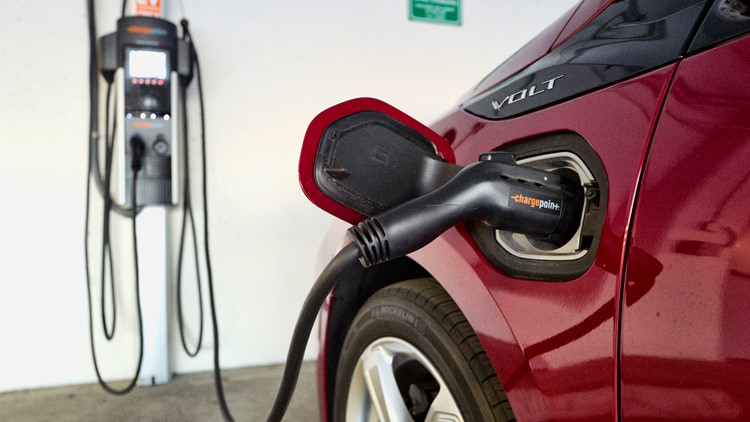RIVERSIDE COUNTY, Calif. — A plan to boost electric car manufacturing and infrastructure in Riverside County aims to jumpstart the region’s economy with highly paid trade and technical jobs while tackling persistent air pollution.
Assemblymember Corey Jackson, a Moreno Valley Democrat, is proposing an electric vehicle opportunity zone in the area, to expand training and education programs for EV technicians and engineers.
The bill could benefit car mechanics who build and maintain the vehicles, electricians and welders who make charging stations to power them, and software developers who design programs to run the cars. The bill would also offer business loans, tax credits, and grants to EV manufacturers.
“We’re trying to mimic what California did for Tesla, to get other people in the game,” Jackson said. “And to make sure those resources are centered in lower income and middle-class communities, not just Silicon Valley or large urban areas.”
The bill passed the Assembly in May and survived the Senate appropriations committee last week, but must win final approval in the Legislature by Aug. 31 to reach the governor’s desk. Startup costs would be at least $4.5 million with $1.2 million in annual expenses after that, according to the bill analysis, making it trickier to pass amid the state’s $47 billion budget deficit.
Jackson and the bill’s supporters maintain it’s a sound investment. Creating well-paid trade and technical jobs is a high priority for leaders in the Inland Empire, a region known as a warehouse center and bedroom community. Local engineering students and other university graduates often commute several hours to work in coastal counties, or leave the region entirely.
The opportunity zone “will help to keep these educated people in the region because there will be jobs for them,” Jackson said.
The biggest beneficiary, at least initially, could be a luxury EV maker.
The precise boundaries of the opportunity zone are yet to be determined, but Jackson said it would likely fall in Moreno Valley, home to Karma Automotive, which has produced 1,000 vehicles so far, at prices starting at $147,000 and reaching $500,000.
These aren’t the commuter cars that will get California to its goal of transitioning all new vehicles to zero emissions by 2035. But Karma President Marques McCammon said its vehicles serve as proof of concept for technology that can eventually be deployed by bigger automakers.
“The easiest way to de-risk new technologies is to release them into markets that have a higher tolerance for risks,” he said.
In other words, customers who can afford an upscale EV will, in effect, test drive new technology. Then other car manufacturers can scale that up to build tens of thousands of electric cars at lower prices.
“I can help my business and shareholders, and also be a support system and a learning laboratory for the broader industry,” McCammon said.
Moreno Valley Mayor Pro Tem Cheylynda Barnard, who’s also executive director of the Inland Empire Labor and Community Center, said the city is rooting for the bill.
“Moreno Valley is ripe with talent and getting this type of innovation in the city would be helpful in creating jobs and opportunities,” she said.
There’s already an automotive hybrid and EV training program at Riverside City College, where students can earn certificates or associate degrees. Jackson’s bill would extend internships and apprenticeships to more students and encourage other EV automakers to locate in the region, said Riverside Community College District Trustee Keri Then.
“While our students are completing certificates or apprenticeships or degree programs they earn while they learn, so they graduate with near zero debt for their experience,” she said.
The EV zone would support skilled trade workers, along with engineers and scientists, creating pipelines for well-paid jobs that don’t require four-year degrees, Jackson said.
“This generation wants to know what they are going to get for spending so much time and money for their education,” he said. “We want to make sure that people know that if you choose this pathway, there’s a job waiting for you. There’s a profession waiting for you.”
For McCammon, the car business is a life-long pursuit. He said he grew up playing with the golden wrench his grandfather received as a Chrysler mechanic. McCammon later earned undergraduate and master’s degrees in mechanical engineering, before working as an engineer and executive at Chrysler and other firms. He hopes to guide Inland Empire students down the same path.
“I want to see more female engineers and technicians,” McCammon said. “I want to see more Blacks and Latinos. I want another generation coming into our industry.”
Jackson’s bill notes that a Riverside County opportunity zone would be a model for other EV hubs around the state. But California will need a broader approach to meet its zero emissions goals, said Orville Thomas, CEO of the California Mobility Center, a Sacramento organization with similar goals of promoting clean technology and transportation.
“I hope we’re not just saying each county has to do their own opportunity zone,” he said. “I hope the state looks at it and says we’re going to do a statewide system that accelerates zero emissions manufacturing.”
But as a starting point Riverside County is a good site for an EV hub, with its proximity to Salton Sea lithium deposits needed for battery production, Thomas said.
Riverside County has a bit of a split personality when it comes to sustainability. It’s a center for lithium mining and other alternative energy projects such as wind and solar farms. Yet Riverside and neighboring San Bernardino County consistently rank among the worst in the nation for ozone and particulate air pollution. Establishing an EV hub won’t immediately fix that, but it could move the needle.
“When the state reaches its climate goals, then the Inland Empire is going to benefit from that,” Jackson said. “The Inland Empire… continues to be one of the fastest growing regions in the state. If we are not buying and transitioning to electric vehicles, then the state as a whole won’t.”
This article was originally published by CalMatters.
WATCH MORE: Are electric vehicles getting more popular?





















